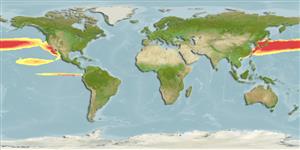>
Stomiiformes (Lightfishes and dragonfishes) >
Sternoptychidae (Marine hatchetfishes) > Maurolicinae
Etymology: Maurolicus: Greek,mauros, -os, -on = dark + Greek,lykos = wolf (Ref. 45335).
Eponymy: Francesco Maurolico (1494–1575) was an Italian mathematician and astronomer from Messina, Sicily. [...] (Ref. 128868), visit book page.
Environment: milieu / climate zone / Tiefenbereich / distribution range
Ökologie
seewasser bathypelagisch; tiefenbereich 50 - 400 m (Ref. 58302). Deep-water
Northwest Pacific: Toyama Bay, Pacific coast of Honshu southward to adjacent waters of Ryukyu Islands and Ogasawara Islands in Japan. Eastern Central Pacific: Hawaii.
Size / Gewicht / Alter
Geschlechtsreife: Lm ? range ? - ? cm
Max length : 5.0 cm SL Männchen/unbestimmt; (Ref. 41299)
Kurzbeschreibung
Bestimmungsschlüssel | Morphologie | Morphometrie
Rückenflossenweichstrahlen (insgesamt) : 10 - 11; Afterflossenweichstrahlen: 21 - 24; Wirbelzahl: 32 - 34.
Benthopelagic (Ref. 58302).
Life cycle and mating behavior
Geschlechtsreife | Fortpflanzung | Ablaichen | Eier | Fecundity | Larven
Nakabo, T., 2002. Fishes of Japan with pictorial keys to the species, English edition I. Tokai University Press, Japan, pp v-866. (Ref. 41299)
IUCN Rote Liste Status (Ref. 130435: Version 2025-1)
Bedrohung für Menschen
Harmless
Nutzung durch Menschen
Tools
Zusatzinformationen
Download XML
Internet Quellen
Estimates based on models
Preferred temperature (Ref.
123201): 7 - 20.8, mean 17.6 °C (based on 128 cells).
Phylogenetic diversity index (Ref.
82804): PD
50 = 0.5000 [Uniqueness, from 0.5 = low to 2.0 = high].
Bayesian length-weight: a=0.00468 (0.00194 - 0.01128), b=3.16 (2.95 - 3.37), in cm total length, based on LWR estimates for this (Sub)family-body shape (Ref.
93245).
Trophic level (Ref.
69278): 3.2 ±0.2 se; based on size and trophs of closest relatives
Widerstandsfähigkeit (Ref.
120179): mittel, Verdopplung der Population dauert 1,4 - 4,4 Jahre. (Assuming Fec < 1,000).
Fishing Vulnerability (Ref.
59153): Low vulnerability (10 of 100).
🛈
